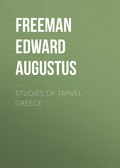
Freeman Edward Augustus
Studies of Travel: Italy
VI. A Glimpse of Samnium
From Caserta and what is to be seen from Caserta, our next journey lies by the line of railway which runs right across Italy, connecting the two great lines of the east and west of the peninsula. It leads us from the Campanian plain, with at least its sheltering wall of mountains, with Tifata to guard the great city that once was from the ruder land beyond, to the great plain of Apulia from which every feature of a mountain-land has passed away. But, in so crossing from one side of Italy to the other, we pass through a striking and an historic region. We are in the land of the mightiest Italian rivals of Rome, the land of those with whom Rome had to fight, before Pyrrhos and Hannibal came, and ages after Pyrrhos and Hannibal were gone.
Our course leads us into the heart of the Samnite land, a land which may well call up endless musings on the hard fate of those "hearts of steel" who bore up so long against Rome, in the days when Rome was really at her greatest. And the memories of the same land in after days are not wholly alien to those of earlier times. Our course brings us, at not a few points, across the memories, if not of nations, yet of men, who had to bear up against the power of Rome, when the power of Rome had taken a far other form than that of the senate and the armies against which the Samnite had to strive. For the old Samnite land holds its place in later story, as the land of princes who felt what the spiritual Rome could do when the powers of the spiritual Rome were at their highest. We pass through regions which were the scene of no small part of the history of the Norman and Swabian lords of Sicily and Southern Italy. We are deep in the land of the counts, dukes, kings, and emperors of the house of Hauteville and the house of Hohenstaufen; and we are often called on to stop and track out their deeds. At not a few points do we light on some building, some inscription, which brings up the memory of Frederick, the Wonder of the World, and of Manfred, whose field of overthrow we shall presently pass by. In both periods the history of these lands has a character altogether different from that of Northern and Central Italy. In the later period this needs no proof: we are dealing with the history of a kingdom, not with the history of a system of separate cities. But something of the same difference extends to the earlier period also. If we wish to know more of Volscians and Hernicans, yet more keenly do we wish to know more of Samnites. The part which they played is greater, at all events in scale, and their dealings with Rome belong to a stage of Roman history when we feel that we have a kind of right to know more than we could hope to know in the earlier time. But while we know something of the character of the Samnite people as a whole, while we know something – though much less than in some other Italian lands – of the geography of the Samnite country, we have no clear notion of the political position or the political action of any particular Samnite city or canton, such as we ever and anon do get of particular cities of Etruria and Latium. And again, it is seldom that we can call up any distinct personal conception of any Samnite leader as a living and breathing man. This is indeed a grievance which affects Samnites along with the other Italian enemies of Rome. The personal conceptions which we do get of Etruscans and Latins largely belong to legendary times. Of historical Volscians we know very few. And we have already complained on Hernican ground that we cannot picture to ourselves the personal likeness of any single Hernican of independent Hernican days.
Still, on this particular journey we have small right to complain; for we pass by the spot which calls up the memories of the most memorable Samnites of whom we have any personal knowledge. They are men of one name, most likely therefore of one house, and men of whom we emphatically wish to know more than we do know. Leaving Caserta behind, glancing at the Campanian plain and the Campanian mountains, marking Naples only by the smoke of the distant city, we pass along through what, in our simplicity, we take to be the vale of Vulturnus, till we light on a more classical friend, armed with a more classical map, who explains that the stream which we are tracing is in strictness not Vulturnus himself, but only his tributary Calor. Anyhow we go along its course into the heart of the Samnite land, and we pass by one spot – a spot which we ought to have treated better than merely to pass it by, a spot round which the greatest memories of Samnite history gather, and where they strangely interweave themselves with wholly different memories of the history of our own land. We reach Telesia, the home of the Pontii, and we remember that Telesia was also for a moment the home of Anselm. Our guide-book provokingly fails us; but the large building on the hill-side must surely be the monastery where he sojourned. There are Roman antiquities in the place; for Samnite antiquities we do not look. But did Samnites build no walls, or do the mighty bulwarks of Cori and Segni mark an earlier state of things than the Sabellian occupation of Southern Italy? Anyhow, we are here at the place which has attached itself as a surname to the two most memorable men in the scanty personal history of Samnium. Here, on his own ground, we remember that Gaius Pontius who spared Rome's army at the Caudine Forks, and who lived to be led, twenty-seven years later, as a spectacle in a Roman triumph, to end his days, one might almost say as a martyr, by the axe of the headsman in a Roman dungeon. So we used to read the tale in our youth; so moralized the historians of our youth over the special baseness which handed over such a man to such an end. Or are we to adopt the new reading of the tale which at least saves Quintus Fabius Maximus from that special stain of blood-guiltiness which cleaves to the canonized memory of Divus Julius? It may be well if we can believe that one of the worthiest heroes of the old commonwealth, if he could not forestall the magnanimity of Pompeius and Aurelian, at least did not sink to the special and petty spite of the murderer of Vercingetorix. We are now taught that the Gaius Pontius who appears twenty-seven years after the first mention of that name, is most likely not the same man as the merciful victor of the Caudine Forks. If this be so, then Quintus Fabius, in consigning his Pontius to the axe, merely conformed to the cruel custom of his nation, without the further aggravation of slaying in cold blood one who had dealt with Rome so nobly. And after all some might hint that the oldest Pontius of all was the wisest. It may be that the sage old father of Gaius knew human nature best, when he bade his son either to massacre the whole Roman army or else to let them go free without terms. It may be that the son chose a more dangerous path than either, when he took to diplomacy and middle courses.
But if the earlier Pontius of Telesia should prove – though the guess is a simple guess – to be in truth two Pontii, perhaps a father and a son, no doubt seems to have fixed itself on the identity of the last Pontius at the Colline gate of Rome. The rising again of Samnite life at the last moment of all, when the war with the allies seemed to have lost itself in the deeper whirlpool of the war of Marius and Sulla, is really the most striking thing in the whole history, such as we have it, of the Samnite people. We are taken by surprise when, in days when Rome already seems the fully established head, not only of Italy, but of all the Mediterranean world, her power, her very being, is threatened by the leader of a nation which seemed to have been dead and buried for some centuries. But, just like the Volumnian tomb in one way, so the Samnite resurrection in another way is a witness to the real life which the other states of Italy kept on under a form of Roman dominion which made them externally dependent, which threw its influence into the scale of oligarchy in their external affairs, which ever and anon subjected them to some irregular demand, but which left the general course of their lives to be whatever they themselves chose it to be. In the days of Marius and Sulla, Etruscans and Samnites were still Etruscans and Samnites; they had not become Romans, nor had they merged their being in any common name of Italians. The Social War itself was the first attempt at forming a general Italian nationality. But the last campaign of the last Pontius shows how deep, in Samnite hearts at least, was the earlier feeling, the feeling which knew no greater whole than the federal union of Etruria or Samnium. It shows too how specially deep was the feeling of hatred for the single city which had brought down so many cities and leagues to become its helpless dependents. Against Pontius at the Colline gate Rome fought for life, as she had never fought since the old days when she had to guard herself against enemies who lived within sight of her capitol. Foreign invaders, Pyrrhos, Hannibal himself, did not come with the same fixed purpose of rooting up the wood which sheltered the wolves of Italy. We can hardly doubt that it is the hand of Sulla which from that day to this has hindered the south of Italy from being like the north. But the blow which crushed the Samnite people as the other nations of Italy were not crushed, was vengeance taken for a moment when it once more became a question whether Rome should rule over Italy, whether Rome should exist at all.
At Telesia we look out, and muse on what might have been, if one Pontius had done otherwise than he did by the forks of Caudium, if another Pontius had fared otherwise than he fared at the gates of Rome herself. At our next halting-place we are called on, not to muse on what might have been, but on what was. At Beneventum we tread the battle-ground of Pyrrhos and Manfred, the ground of two of the greatest victories of the Rome of the earlier and the Rome of the later day. There we need not strive to call up the dim figures of men, like the older and the later Pontius, known by one action of their lives. The Epeirot and the Swabian stand out as clearly discerned figures in the history of their several ages. And the places where we next halt will show us the place of overthrow for both, the place of death and utter ruin for one.
VII. Benevento
We follow the stream of Calore till we reach a city which, without ever having been one of the great cities of the world, without having been even one of the greatest cities of Italy, has always kept up an important historic being. Beneventum is a familiar name in all ages; yet Beneventum has never been either a mighty commonwealth like Venice or Genoa, or the head of a mighty kingdom like Naples and Palermo. It has had its princes; if we never heard of them before, we should learn a good deal of them by studying the monuments of their city. That is to say, the monuments will tell us a great deal about princes nine hundred or a thousand years back; no monument that we remember in Benevento tells us anything about the last prince who bore their title. Let us suppose a wanderer who began his travels at Autun and who finds himself, in the course of the same wandering, at Benevento. He will feel it as a grotesque coincidence that, not so very long ago, a man was living who had once been Prince of Benevento and who before that had been Bishop of Autun. Benevento, among many other things that it is, is also the later city of Talleyrand, as Autun is the earlier. But there is this difference that one thinks of Talleyrand at Autun and one does not think of him at Benevento. At Autun he has his place, though a very strange place, in the long succession of Bishops of Autun; at Benevento, though he bore the style of its prince, he stands all alone; we cannot find a niche for him in the succession of the Beneventan princes. Yet a prince of Benevento whose existence marks the ending for a season of the long papal dominion in Benevento reminds us that Benevento had its princes before that papal dominion began. It reminds us of the two distinctive features in the later history of the city. Benevento was first the seat of Lombard princes who, placed on the borders of both empires, contrived to escape all practical submission to either; it was then the seat of an outlying scrap of papal dominion surrounded on all sides by the Sicilian realm. In both these characters Benevento was a kind of curiosity on the historical map of Europe. But the city had its ups and downs before those days, and amongst other things it had gone through a somewhat grotesque change of name. It is hard to believe that a city placed so far inland can really have been of Greek origin; but legend attributed it to a Greek founder, and its oldest name had a Greek sound. Greek Maloeis, Samnite Maluentum, had, when it was read into Latin Maloventum, an ill sound; so, when the Samnite stronghold was changed into the Roman colony, it took the name of Beneventum, city of welcome.
Beneventum, marked by Procopius as a strong city in a high place, stands low as compared with the true hill-cities. Still, as compared with Capua, it might itself pass for a hill-city. It has just that amount of rise above the river which there commonly is where there is a river, such a rise as may be seen in many an English town which is not as Durham or Lincoln. We miss the primæval walls of the hill-cities; but we find, on the other hand, works of Roman and mediæval art such as in the hill-cities we do not find. The arch of Trajan has vanished from Rome, except so far as it lives in the sculptures which were torn from it to enrich the arch of Constantine. But at Benevento, as at Ancona, the memorial of the conqueror of Dacia still abides. The Beneventan arch may indeed fairly take its place in the Roman series. It belongs essentially to the same class of designs as the arch of Severus and the arch of Constantine, while it has little in common with its own tall and slender fellow at Ancona. At the same time, since it has, in general effect at least, taken upon itself something of the position of a town-gate, since it bears the name of Porta aurea, to match the golden gate of Constantinople and the golden gate of Spalato, the arch of Beneventum has now a somewhat greater air of reality than triumphal arches commonly have. The weak point of that class of structures is that they are of no use. They do not, like a wall, a gateway, a house, a temple, a hall of council, serve any purpose in the ordinary economy of things. They are purely monumental, set up to commemorate something or somebody, but in no way to help on men's daily affairs, public or private. And yet they are not mere monuments, like a statue or an inscribed stone. A large building of this kind, having very much the air of a building which does serve some purpose, is a little deceptive. It is so like a real gateway that it calls up the thought of a real gateway, and leaves us a little disappointed at finding that the building, after all, never was of any use to anybody, and was set up simply to be looked at. There is, therefore, something a little unsatisfactory in the whole class of triumphal arches, and it may even be that a slightly ludicrous element is thrown in when we find that the immediate occasion for rearing this record of the life and exploits of the "fortissimus princeps" whom it commemorates was the repair of the Appian Way. But it does not become us to find fault with any built and graven monument, specially with one of a time of which we have so few written monuments as the memorable reign of Trajan. We are so much the slaves of accidental associations, so apt to draw lines at some altogether unreasonable point, that we may doubt whether the reign of Trajan holds the place which it should hold in popular imagination. Suetonius wrote the lives of Twelve Cæsars, and this mere accident has caused the notion of a break which has no real existence between the Suetonian Twelve and those who next followed them. The reign of Trajan marks the Empire at its highest pitch of extent and power, at that highest pitch which, in its own nature, comes just before the beginning of decay. His days saw, too, the highest pitch of architectural magnificence; and with Tacitus and Juvenal to adorn it, one might be inclined to say that, as an age of Latin literature, the age of Trajan might hold its own against any earlier period of the Imperial rule. For we must remember that the great writers of the early days of Augustus are in truth writers of the republican period living on into the Empire. The Flavian period, continued under Trajan, is quite as rich as the earlier days of the Empire itself. And we may notice that the arch of Beneventum marks the reign of Trajan, and with it the Roman Empire, at what was really its highest point. It was raised at a time when it could commemorate conquered Dacia and tributary Armenia. That Dacia and Armenia could be brought within the range of that Roman world which is continued in the system of modern Europe is proved by daily witnesses. But the arch of Beneventum was built too early to commemorate its hero's later victories in the further East, momentary victories in lands which neither Alexander nor Trajan could bring within the abiding range of Western influences.
The arch of Trajan is so distinctly the most famous thing in Benevento that it has carried us out of all chronological order. But the historical interest of Beneventum lies earlier and later than Trajan's day. In truth the Pax Romana forbade that the main interest of any Italian city should lie in Trajan's day. We may believe or not as we please in the presence of Diomêdês and Æneas; but Pyrrhos, Hanno, Totilas, and Manfred are visitors who cannot be forgotten. The city has looked out on many battles, from the overthrow of the Molossian to the overthrow of the Swabian. A pleasing tale in its history is when that Tiberius Gracchus who is the first of a name to appear in Roman history led back his victorious slave-soldiers to receive the reward of freedom, and to be welcomed by the rejoicing people of the faithful colony. For among the Thirty Cities of those days, the Latin colony of Beneventum was not one of the laggard twelve, but one of the faithful eighteen that were ready to endure all hardships. In later warfare the city seems to have been less steadfast. It welcomed Belisarius, and in after days Totilas took it without any trouble, and if he destroyed the walls it was not out of revenge for any resistance on the part of its inhabitants, but for fear they should supply a post of defence for an imperial army. But the greatest day of Beneventum as an historical city comes later than Totilas and earlier than Manfred. The memory of that day may be studied in the chief remaining buildings in the city, the two greatest churches and the castle. The west front of the metropolitan church, a grand example of Italian Romanesque, is furthermore a perfect chronicle of local history. There we may read, built up into the wall, a crowd of monumental records of the Lombard princes of Beneventum, with their deeds, especially their dealings with the dangerous power of the Franks, set forth at length. The bronze doors are famous, with their long array of Scriptural subjects ending in a lesson in the ecclesiastical geography of the province, the figures of the Archbishop of Beneventum and his suffragans. The harmony of the front is a little marred by the single low and massive corner-tower; but the inscription sums up the history of Beneventum, political and physical, for some ages. The city was laid waste by the Emperor Frederick in 1229 and by an earthquake in 1688. The tower was built after the first overthrow in 1279; it was restored after the second in 1690. Destruction wrought by the elements would thus seem to be more easily repaired than destruction wrought by the hand of Cæsar. But it is somewhat strange to find Frederick, in his own belief a successor of Trajan, a follower of Trajan in Eastern conquests, branded as a destroyer in the city where Trajan's memory is cherished. But Frederick had to deal with a kind of power which Trajan knew not. The wrath of the later Emperor fell on a city which was too faithful to the Roman Bishop. The course of Trajan's rule was not likely to be interfered with either by the obscure chief of the persecuted Christian sect, or by any minister of the creed of which Trajan was himself chief Pontiff.
Within the church the repairs done after the earthquake have wrought a good deal of mischief. But we can still see the four ranges of columns of a mighty basilica which must once have taken its place among the noblest of its class. Their capitals are a little nondescript; but they do not offend the eye; if they were certified to be of Trajan's day, it would doubtless be the right thing to admire them. The ambones and the Easter-light are lovely work of the early fourteenth century, the days of a real Renaissance, truer than that which followed. The treasury is rich in vestments and other precious things; but the reader of Anselm's Life looks in vain for that specially gorgeous vestment which a Beneventan Archbishop of the eleventh century bore away from Canterbury in exchange for the arm of St. Bartholomew, and which made its wearer the most splendid object among the assembled fathers at Bari. If this missing garment carries our thoughts to England, the round church of St. Sophia – hexagonal in its inner range – carries us to the Eastern world, and reminds us that there was more than one line of successors of Trajan, and that Beneventum came under the influences of both. The cloister, with its amazing series of capitals, its birds, its elephants, its hunting scenes, may rank with those of Aosta and of Arles, of which that of Aosta can supply camels to match the Beneventan elephants. The castle dates only from Pope John the Twenty-second, far away at Avignon; we look perhaps more carefully at the older fragments built up in its walls and on the lion in front of it. With the lion in our thoughts we may look out for other beasts, graven or molten or abiding in their own relics. Procopius saw there the tusks of the Kalydonian boar, as in later times he might, either at Warwick or at Bristol, have seen the ribs of the dun cow. It is for palæontologists to say what it was that the Beneventan antiquaries really showed him. Failing this natural wonder we go to pay our respects to another beast whose shape is due to man's device, in quite another part of the city. A rudely carved bovine animal, in which local patriotism sees the Samnite bull – the bull which, on the coins of revived Samnium, so proudly trampled down the Roman wolf – is now cruelly to be ruled as nothing better than a monument of intruding Apis-worship. We have less time to spend at Benevento than at some other cities; but the Roman arches and vaults of the strange building called Quaranta Santi, the grand Roman bridge below, must not be forgotten, and we must still give one more thought to the two mighty men whose hopes were shattered at Beneventum. Manfred fell with his faithful Saracens around him; Pyrrhos lived to fall by a meaner end at Argos; but Beneventum ended the real career of both. It is strange how the two were in some sort the converse of each other. Pyrrhos carried the Epeirot arms into Sicily and southern Italy; Manfred, lord of Sicily and southern Italy, established a Sicilian dominion on the coast of Epeiros. Korkyra, Corfu, the island which has seen every master except the Turk, formed part of the dominions of both alike. We leave Benevento for another city in which the East and the West of Europe, and a crowd of other elements besides, meet yet more closely than they do at Benevento. At Beneventum the eye of Horace began to be caught by the well-known mountains of Apulia; Procopius somewhat boldly speaks of inland Beneventum as being opposite to Dalmatia. The city which we take as our next chief goal, if not strictly opposite to Dalmatia, is so marked as being opposite to one Illyrian port as to have sent its name, so to speak, across the Hadriatic. We will not trouble ourselves to look out for Equotuticum, or to regale ourselves with either the bread or the water of Canusium. It is to the walls of Bari, fishy Bari, that we have to make our way; at Bari, Greek, Latin, Saracen, even Englishman, are all at home, and Bari is opposite to Antivari.







